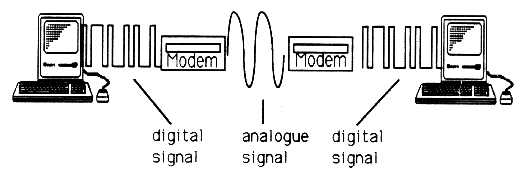

The device which converts digital data to analogue form is known as a MOdulator - DEModulator, or modem for short. A typical arrangement for this is shown below:

Basically, there are three main approaches to modulation:
Most slow-speed modems use either frequency or amplitude modulation. Modulation can be defined as the alteration of a frequency to carry data. The frequency which is modified is known as a carrier frequency and the data signal used to modulate the carrier is known as the baseband signal.
In this approach to modulation, zeroes and ones are represented by different frequencies on the line. For example, a zero could be represented by a tone of 1500 Hz and a one by a tone of 2000 Hz. If actually listened to a zero would be like a low note whereas a one would be of slightly higher pitch. Frequency modulation is shown in the diagram below:

In this instance, zeroes and ones are represented by different voltages on the line. For example, 20 volts could represent a zero and 10 could illustrate a one. Obviously, if listened to a zero would sound like a loud note and a one would sound quiet. The diagram below shows this:

Another form of modulation, particularly useful in achieving high transmission speeds, is known as phase modulation. In this case each bit of data is represented by a phase shift, relative to the previous phase of the carrier. For example, the diagram below illustrates this concept, when a zero is encoded as a 90 degree phase shift and a one by a 270 degree shift:

The significant difference between phase modulation and the other two methods considered earlier is that it is the change between one phase and another which represents the data bit and not the actual frequencies involved.
To obtain even higher transmission speeds more than two phase shifts could be employed. If four phase shifts are used, each can represent two bits of data, known as a DIBIT.
This technique allows a data transmission link with a nominal rate of 2400 bits/sec to operate at 4800 bits/sec. The diagram below shows this:

Lastly, a further increase in speed can be obtained by allowing a combination of phase and amplitude modulation. For example a TRIBIT exists when each change of phase and amplitude can represent three bits.